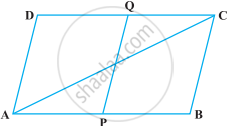Advertisements
Advertisements
प्रश्न
ABCD is a rectangle in which diagonal BD bisects ∠B. Show that ABCD is a square.
उत्तर
Given: In a rectangle ABCD, diagonal BD bisects ∠B.
Construct: Join AC.
To show: ABCD is a square.

Proof: In ΔBAD and ΔBCD,
∠ABD = ∠CBD ...[Given]
∠A = ∠C ...[Each 90°]
And BD = BD ...[Common side]
∴ ΔBAD ≅ ΔBCD ...[By AAS congruence rule]
∴ AB = BC
And AD = CD [By CPCT rule] ...(i)
But in rectangle ABCD, opposite sides are equal.
∴ AB = CD
And BC = AD ...(ii)
From equations (i) and (ii),
AB = BC = CD = DA.
So, ABCD is a square.
Hence proved.
APPEARS IN
संबंधित प्रश्न
Diagonals of a parallelogram `square`WXYZ intersect each other at point O. If ∠XYZ = 135° then what is the measure of ∠XWZ and ∠YZW?
If l(OY)= 5 cm then l(WY)= ?

The diagonals AC and BD of a parallelogram ABCD intersect each other at the point O. If ∠DAC = 32º and ∠AOB = 70º, then ∠DBC is equal to ______.
Points P and Q have been taken on opposite sides AB and CD, respectively of a parallelogram ABCD such that AP = CQ (Figure). Show that AC and PQ bisect each other.

In the following figure, AB || DE, AB = DE, AC || DF and AC = DF. Prove that BC || EF and BC = EF.

P and Q are points on opposite sides AD and BC of a parallelogram ABCD such that PQ passes through the point of intersection O of its diagonals AC and BD. Show that PQ is bisected at O.
P is the mid-point of the side CD of a parallelogram ABCD. A line through C parallel to PA intersects AB at Q and DA produced at R. Prove that DA = AR and CQ = QR.
If the diagonals of a quadrilateral bisect each other, it is a ______.
The point of intersection of diagonals of a quadrilateral divides one diagonal in the ratio 1:2. Can it be a parallelogram? Why or why not?
Two sticks each of length 7 cm are crossing each other such that they bisect each other at right angles. What shape is formed by joining their end points? Give reason.
